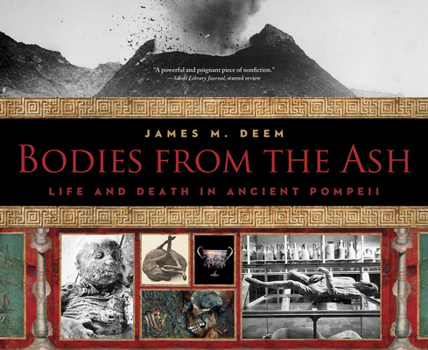Bodies from the Ash: Life and Death in Ancient Pompeii
Select Format
Select Condition 
Book Overview
In ancient times, Pompeii was one of the largest cities in the Roman Empire. Its 20,000 inhabitants lived in the shadow of Vesuvius, which they believed was a mountain. But Vesuvius was an active volcano, and within twenty-four hours of its eruption, the city was destroyed. Hundreds of years later, archaeologists unearthed what was buried under the rubble. The most unexpected and extraordinary discovery? The imprints of Pompeiians, their deaths...
Format:Paperback
Language:English
ISBN:1328740838
ISBN13:9781328740830
Release Date:October 2017
Publisher:Clarion Books
Length:64 Pages
Weight:0.65 lbs.
Dimensions:0.2" x 10.9" x 8.8"
Age Range:10 to 12 years
Grade Range:Grades 5 to 7
Customer Reviews
3 ratings
Excellent book!
Published by Thriftbooks.com User , 14 years ago
Having visited Pompeii in March, this book was particularly poignant to me. Though it is written for kids, it is very well done. A good book to whet the appetite for more.
Great Book!
Published by Thriftbooks.com User , 15 years ago
I loved this book. The pictures were fabulous. The background material and research was very informative. I am going to Pompeii next fall and wanted to bone up on the history. Easy, interesting read.
Pompeii and circumstance
Published by Thriftbooks.com User , 18 years ago
Having only just begun his examination of the ancient dead with, "Bodies From the Bog" (a title that bears more than a passing resemblance to a kitchy 1950s horror flick), Mr. James M. Deem returns to look at the ancient dead of an entirely new region. As a child I was fascinated by mummies and the bodies of human beings from so very long ago. History was never my favorite subject and often I found that unless I could see a person in the flesh (rotting, decomposing, flaking flesh though it might be) I was unable to understand how similar to us the people of the past were. Pompeii, naturally, is a fascinating subject in and of itself. How could it not be? You've three-dimensional images of people in the last throes of death. I challenge anyone to come up with anything half as gripping (i.e. feeding on our more macabre instincts) when talking about any other ancient civilization. With plenty of amazing photographs, clear concise writing, and a plot that will keep many a kid spellbound, this is probably one of the finest non-fiction titles to grace library bookshelves in years. "On August 24, the last Tuesday that they would live in their town, the people of ancient Pompeii awoke to a typical hot summer's morning". And we're off! No long drawn out Preface on why Deem wrote this book or dull page long sermon on the history of archeology itself. Nope. Instead we are treated to a highly accurate encapsulation of the events that lead up to Mount Vesuvius erupting and the good people of Pompeii perishing. With some reliance on the accounts of Pliny Jr., Deem tells us what happened on August 24 and 25, A.D. 79. There's even a timetable of events marking the different stages in the eruption. With everyone dead and buried beneath different amounts of ash, Deem then looks at the consequential rediscovery of this once bustling town. We learn how in 1709 a group of diggers found the nearby town of Herculaneum and plundered it of its riches. Pompeii wasn't found until 1748 when discovering the city was something akin to a treasure hunt. For the tourists, skeletons found were set up in dramatic tableaux. Then, around 1860, our hero Guiseppe Fiorelli had the previously inconceivable notion that maybe someone should try preserving Pompeii and its bodies. When people came across hollow areas in the ash, it was Fiorelli who had the brilliant idea to pour plaster into the holes and create life sized statues of what the people in their last moments looked like. The rest of the book discusses the fate of the plaster casts, what we've learned about the residents of Pompeii, and the interesting stories found in the nearby town of Herculaneum. The book ends with the sorry state of current Pompeii excavation and a call for people to make note of the swift decomposition of what we've already found. Knowing perfectly well that Pompeii alone does not a children's non-fiction text make, Deem's decision to talk about Herculaneum as well was an intellige





